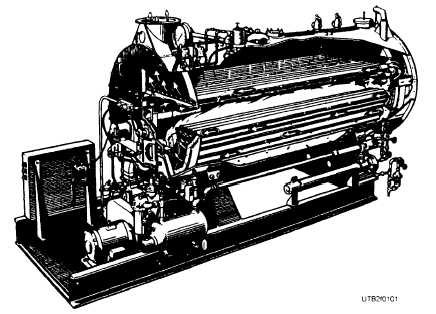ranging from 100.000 to 1,000,000 pounds of steam per hour. In case of tube failure, there is little danger of a disastrous explosion of the water-tube boiler. The furnace not only can carry a high overload, it can also be modified for tiring by oil or coal. Still another advantage is that it is easy to get into sections inside the furnace to clean and repair them. There are also several disadvantages common to water-tube boilers. One of the main drawbacks of water-tube boilers is their high construction cost. The large assortment of tubes required of this boiler and the excessive weight per unit weight of steam generated are other unfavorable factors.
FIRE-TUBE BOILERS
There are four types of fire-tube boilers - the Scotch marine boiler. the vertical-tube boiler, the horizontal return tubular boiler. and the firebox boiler. These four types of boilers are discussed in this section.
Scotch Marine Boiler
The Scotch marine tire-tube boiler is especially suited to Seabee needs. Figure 1-1 is a portable Scotch marine tire-tube boiler. The portable unit can be moved easily and requires only a minimal amount of foundation work. As a complete self-contained unit. its design includes automatic controls. a steel boiler. and burner equipment. These features are a big advantage because no disassembly is required when you must move the boiler into the field for an emergency.
The Scotch marine boiler has a two-pass (or more) arrangement of tubes that run horizontally to allow the heat inside the tubes to travel back and forth. It also has an internally fired furnace with a cylindrical combustion chamber. Oil is the primary fuel used to fire the boiler; however. it can also be fired with wood, coal, or gas. A major advantage of the Scotch marine boiler is that it requires less space than a water-tube boiler and can be placed in a room that has a low ceiling.
The Scotch marine boiler also has disadvantages. The shell of the boiler runs from 6 to 8 feet in diameter, a detail of construction that makes a large amount of reinforcing necessary. The fixed dimensions of the internal surface cause some difficulty in cleaning the sections below the combustion chamber. Another drawback is the limited capacity and pressure of the Scotch marine boiler.
An important safety device sometimes used is the fusible plug that provides added protection against low-water conditions. In case of a low-water condition. the fusible plug core melts, allowing steam to escape, and a loud noise is emitted which provides a warning to the operator. On the Scotch boiler the plug is located in the crown sheet, but sometimes it is placed in the upper back of the combustion chamber. Fusible plugs are discussed in more detail later in this chapter.
Access for cleaning, inspection, and repair of the boiler watersides is provided through a manhole in the top of the boiler shell and a handhold in the water leg. The manhole opening is large enough for a man to enter the

Figure 1-1. - Scotch marine type of fire-tube boiler.
Continue Reading